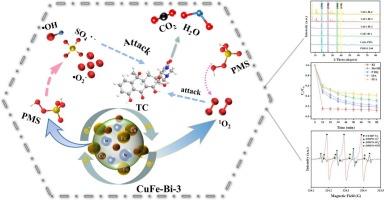原位铋掺杂对普鲁士蓝类似物活化PMS催化体系降解四环素性能调控机理的研究
IF 6.7
2区 工程技术
Q1 ENGINEERING, CHEMICAL
引用次数: 0
摘要
普鲁士蓝类似物(PBAs)在污染物降解中显示出潜力,但往往受到晶体结构调节和活性位点暴露不足的限制。本研究利用Bi掺杂对CuFe-PBA的晶体结构和电子环境进行协同优化,构建了一种高效的CuFe-Bi-3催化剂,用于过氧单硫酸盐(PMS)活化降解四环素(TC)。Bi的引入诱导晶面重构,增强了Cu2+/Cu+和Fe3+/Fe2+循环,增加了活性位点的暴露。在80 min内,CuFe-Bi-3的TC降解率从72.2%提高到92.1%,反应速率常数从0.01133提高到0.02631 min−1。机制研究表明,Bi调控促进了1O2的定向生成和利用,构建了一个以非自由基为主的协同氧化途径。综合比较各种活性氧的EPR信号,发现1O2信号最强,显著高于O2•-、•OH和SO4•-。该体系在各种水质中具有良好的稳定性和较宽的pH范围,毒性评价也表明它能有效降低降解产物的毒性。本研究为PBAs催化剂的结构电子调控和Bi掺杂在复杂水环境下构建环保高效的PMS活化体系提供了理论支持和应用参考。本文章由计算机程序翻译,如有差异,请以英文原文为准。

Study on the performance regulation mechanism of in-situ Bi doping on the degradation of tetracycline by Prussian blue analogue activated PMS catalytic system
Prussian blue analogues (PBAs) show potential in pollutant degradation, but are often limited by crystal structure regulation and insufficient exposure of active sites. In this study, Bi doping was used to synergistically optimize the crystal structure and electronic environment of CuFe-PBA and construct an efficient CuFe-Bi-3 catalyst for peroxymonosulfate (PMS) activated degradation of tetracycline (TC). The introduction of Bi induces crystal plane reconstruction, enhances the Cu2+/Cu+ and Fe3+/Fe2+ cycles, and increases the exposure of active sites. The TC degradation rate of CuFe-Bi-3 increased from 72.2 % to 92.1 % within 80 min, and the reaction rate constant increased from 0.01133 to 0.02631 min−1. Mechanistic studies have shown that Bi regulation promotes the directional generation and utilization of 1O2, constructing a synergistic oxidation pathway dominated by non-free radicals. A comprehensive comparison of EPR signals for various reactive oxygen species showed that the 1O2 signal was the strongest, significantly higher than O2•-, •OH and SO4•-. The system has good stability in various water qualities and a wide pH range, and toxicity assessment also shows that it can effectively reduce the toxicity of degradation products. This study provides theoretical support and application reference for the structure-electronic regulation of PBAs catalysts and Bi doping to construct an environmentally friendly and efficient PMS activation system in a complex water environment.
求助全文
通过发布文献求助,成功后即可免费获取论文全文。
去求助
来源期刊

Journal of water process engineering
Biochemistry, Genetics and Molecular Biology-Biotechnology
CiteScore
10.70
自引率
8.60%
发文量
846
审稿时长
24 days
期刊介绍:
The Journal of Water Process Engineering aims to publish refereed, high-quality research papers with significant novelty and impact in all areas of the engineering of water and wastewater processing . Papers on advanced and novel treatment processes and technologies are particularly welcome. The Journal considers papers in areas such as nanotechnology and biotechnology applications in water, novel oxidation and separation processes, membrane processes (except those for desalination) , catalytic processes for the removal of water contaminants, sustainable processes, water reuse and recycling, water use and wastewater minimization, integrated/hybrid technology, process modeling of water treatment and novel treatment processes. Submissions on the subject of adsorbents, including standard measurements of adsorption kinetics and equilibrium will only be considered if there is a genuine case for novelty and contribution, for example highly novel, sustainable adsorbents and their use: papers on activated carbon-type materials derived from natural matter, or surfactant-modified clays and related minerals, would not fulfil this criterion. The Journal particularly welcomes contributions involving environmentally, economically and socially sustainable technology for water treatment, including those which are energy-efficient, with minimal or no chemical consumption, and capable of water recycling and reuse that minimizes the direct disposal of wastewater to the aquatic environment. Papers that describe novel ideas for solving issues related to water quality and availability are also welcome, as are those that show the transfer of techniques from other disciplines. The Journal will consider papers dealing with processes for various water matrices including drinking water (except desalination), domestic, urban and industrial wastewaters, in addition to their residues. It is expected that the journal will be of particular relevance to chemical and process engineers working in the field. The Journal welcomes Full Text papers, Short Communications, State-of-the-Art Reviews and Letters to Editors and Case Studies
 求助内容:
求助内容: 应助结果提醒方式:
应助结果提醒方式:


